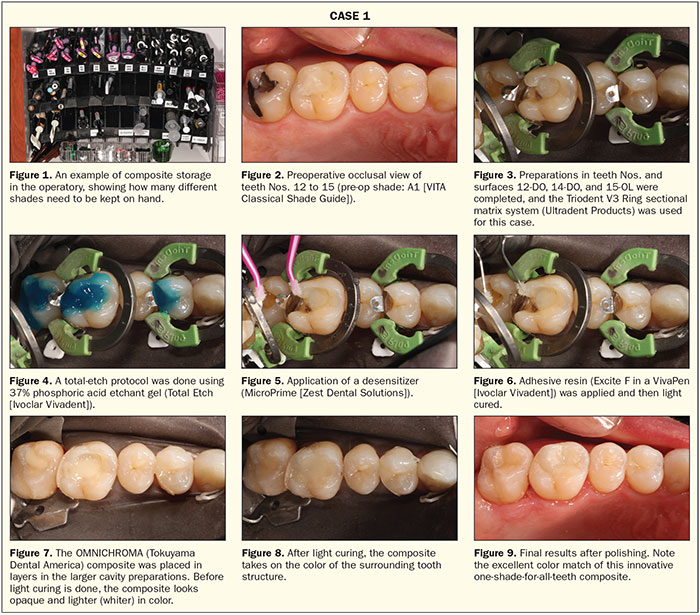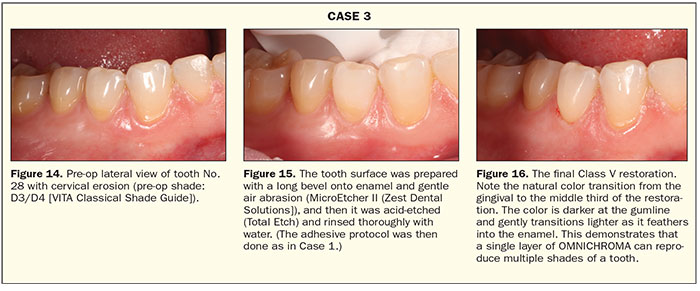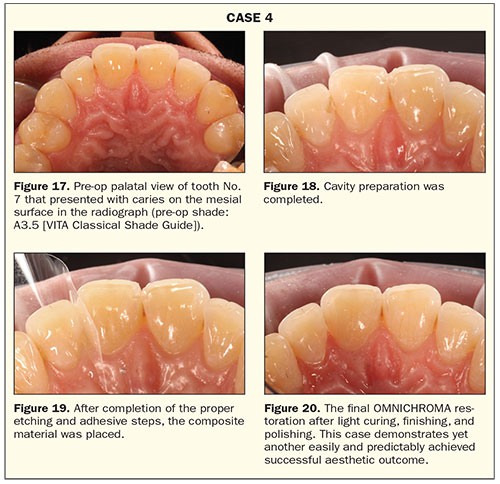INTRODUCTION
Being a general dentist in these fast-changing times can be a bit nerve racking and yet very exhilarating. On one hand, we are feeling the negative influences of dental insurance companies making it challenging to provide quality care and still earn enough to cover the ever-increasing overhead costs. On the other hand, it is very exciting and fulfilling to be able to successfully treat our patients using innovative technologies and dental materials, improving their oral health and confidence.
In general, the bread and butter procedure for most general dental practices is the restoration of decayed teeth or replacing old existing restorations with direct composite resin materials. Direct composite restorations have evolved over time. The profession has witnessed many improvements in the physical characteristics of these materials, making them more user friendly for the clinician and longer lasting for the patient. One aspect of dental resins that has gone unchanged is the way in which they are colored, requiring many different shades to be kept in stock in the dental office. Traditionally, one of the challenges when placing direct composite restorations lies in choosing the best shade option (or combination of shades) from a range of many colors that will best fit the clinical situation at hand. Having the full range of shades available can be costly and time consuming to keep track of in the ordering process.
Introducing an Innovative Solution
A new and unique composite resin material (OMNICHROMA [Tokuyama Dental America]) has been developed and recently introduced that utilizes one shade of composite to match all tooth shades. OMNICHROMA is the world’s first composite resin system that offers a single shade to match every patient. This game-changing material simplifies direct composite restorations on many levels. This case report article will demonstrate a few different common clinical uses of OMNICHROMA in the posterior and anterior segments while describing how using this material can make the work day easier and more efficient for the general practitioner.
An Innovative Development in Composite Materials
A typical composite resin obtains its shade based upon chemical coloring agents that are added in order to match one of the 16 shades on the VITA shade guide. When a tooth is being restored, the clinician, often in a team effort involving the chairside assistant, must select the shade of the composite that will match closest to that patient’s tooth. This requires a typical dental office to keep many shades of composite in stock at all times. The most common shades of composite (A1, A2, and A3) are used frequently, while the less commonly used shades (C and D) are often wasted because they expire before being completely used up (Figure 1). It can be a frustrating task for the dental assistant to keep a vigilant eye on what is in stock, when it expires, when to order more, and how much to purchase. How many dentists and assistants have wished that they could simplify this work by using one color of composite for all of their patients?
OMNICHROMA’s Smart Chromatic Technology is the first composite to use structural color, not chemical color, as the primary color mechanism. The detailed science behind structural vs chemical color will not be discussed in this article; however, a simplified explanation will be offered here to understand basically how the material works.
The human dentition exhibits color exclusively within the red-yellow spectrum of color. As light passes through OMNICHROMA’s uniquely designed, spherical, and uniformly-sized fillers, it is structurally altered to be within the red-yellow spectrum; this allows the material to mimic the surrounding tooth color to that of which it is being bonded. This structural alteration (of light) technology allows OMNICHROMA to match all shades in the human dentition: one composite for all patients. In addition to its unique color-matching characteristics, the composite exhibits excellent physical and mechanical properties that are inherited from the Estelite Sigma Quick (Tokuyama Dental America) system. Indications include, but are not limited to, direct anterior and posterior restorations, direct composite veneers, diastema closures, and repair of existing porcelain and/or composite restorations.
CASE REPORTS
The following are briefly presented case examples that showcase the use of OMNICHROMA in a variety of clinical applications frequently done in a general practice.
Case 1
The first example illustrates a standard posterior Class II composite restoration on teeth Nos. and surfaces 12-DO, 14-DO, and 15-OL (Figure 2). The preoperative shade was A1 (VITA Classical Shade Guide) for all the involved teeth. After placement of a rubber dam for proper isolation, the decay was removed, and the preparations were refined using a carbide bur (Komet). For best results for both bond strength and optimal marginal color masking, the cavo-surface margin should be slightly beveled.1 The Triodent V3 Ring sectional matrix system (Ultradent Products) was used to obtain interproximal isolation for the Class II restorations (Figure 3). A Total Etch protocol was followed, using 37% phosphoric acid etch (Ivoclar Vivadent) (Figure 4). After thoroughly rinsing the preparations and teeth with water, a desensitizer was applied (MicroPrime [Zest Dental Solutions]) (Figure 5). Next, the bonding adhesive (Excite F in a VivaPen [Ivoclar Vivadent]) was applied (Figure 6) and light cured (Bluephase LED curing light (Ivoclar Vivadent]) per the manufacturer’s instructions. The proximal boxes were filled with composite first, and then the matrices and rings were removed. The OMNICHROMA composite was applied in layers to minimize C-factor stress found to be associated with larger composite resin fillings.2 As the OMNICHROMA composite is placed into the cavity preparation, it looks opaque white before light curing (Figure 7). After it is light cured, it changes color to match the surrounding tooth color (Figure 8). After finishing (with carbide finishing burs [Kerr Rotary] and Sof-Lex disks [3M]) and the final polishing (such as with Kerr Dental’s PDQ Composite Polishing Brush), the color match is improved even further (Figure 9).
 |
Case 2
The second example involved caries in the interproximal (mesial) surface of tooth No. 14 (Figure 10). The pre-op shade was A3 (VITA Classical Shade Guide). In this case, isolation was achieved using a simple and quick-to-place lip retractor (OptraGate [Ivoclar Vivadent]). The interproximal decay was removed, and the tooth was prepared for the placement of the MO composite restoration (as described in Case 1) (Figure 11). This clinical example also shows the opaque white color of the OMNICHROMA composite before it is light cured (Figure 12). Finishing and polishing of the restoration was achieved in the same fashion as in Case 1 (Figure 13). The final restoration blends in seamlessly with the natural tooth structure.
 |
 |
Case 4
The final example is of a mesiolingual carious lesion in tooth No. 7 that was restored using OMNICHROMA (pre-op shade: A3.5 [VITA Classical Shade Guide]) (Figure 17). This case is being shared because these restorations can often be seen from the frontal view over time as the composite restoration discolors or if the patient whitens his or her teeth at some point after the work is done. With this material’s Smart Chromatic Technology, the structural color mechanism allows the composite to generate the same wavelengths of light as the surrounding tooth structure. As a result, composite placement in the anterior segment is less stressful when using this innovative composite system. After cavity preparation (Figure 18), and following a proper etch and adhesive protocol (as in the cases described above), a clear mylar shim was used for interproximal separation. Next, the cavity was filled with the OMNICHROMA composite (Figure 19) and light cured. Finishing and polishing enhanced the shade matching of the composite (Figure 20).
 |
CLOSING COMMENTS
There are many excellent dental composite systems on the market that do a good job with color matching and mechanical properties. Tokuyama Dental America’s OMNICHROMA is a game changer in that it allows dentists to simplify their lives by using one composite for all direct composite applications. It will reduce inventory, stress, and overhead while improving profitability, predictability, and patient satisfaction.
References
- Terry DA, Leinfelder KF. Composite resin restorations: a simplified approach. Inside Dentistry. 2008;4.
- Eick JD, Welch FH. Polymerization shrinkage of posterior composite resins and its possible influence on postoperative sensitivity. Quintessence Int. 1986;17:103-111.
Dr. Brown received his DDS degree in 2006 from the University of Washington School of Dentistry, with recognition in restorative dentistry. In 2013, he received accreditation from the American Academy of Cosmetic Dentistry, and he has published numerous articles on direct/indirect anterior restorations in the Journal of Cosmetic Dentistry and other publications. He maintains a private practice in Bellevue, Wash. He can be reached via email at kbrown@jensenbrowndds.com.
Disclosure: Dr. Brown received honorarium from Tokuyama Dental America for writing this article.
Related Articles
Direct Composite Veneers: A Viable Treatment Option
Direct Composite Resin Veneers


